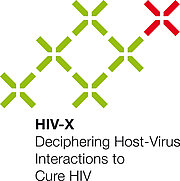HIV-X
Deciphering Host-Virus Interactions to Cure HIV
There is still no cure available that completely eliminates HIV from the human body. One reason for this is that the virus is able to establish a viral reservoir. The researchers of the HIV-X MRD Project will investigate how HIV persists, and plan to develop models to predict individual treatment responses.
Human immunodeficiency virus (HIV) is the cause of a devastating pandemic that currently affects about 35 million people around the world, with about 3.4 million new cases appearing every year. Its life cycle allows HIV life-long persistence in the human body, by integrating its genome into the human genome and establishing a so-called viral reservoir, a population of infected cells, which perseveres in spite of treatment.
Understanding how HIV persists
To date, combinations of antiretroviral drugs have been highly effective in dramatically reducing mortality by inhibiting viral replication, but they have so far failed to eliminate the viral reservoir. Understanding how HIV persists despite this treatment is crucial to the development of strategies for the eradication of the viral reservoir.
The HIV-X MRD Project has the ambitious goal of identifying host and viral factors that play a role in the pathomechanisms of HIV latency. Once these factors have been revealed, the researchers plan to establish models to predict treatment responses, and to identify the group of HIV-positive individuals with the best chances of being cured by effective reservoir-depleting drugs, once they become available.
Identifying the factors underlying latency
To achieve their goals, the researchers will take advantage of the Swiss HIV Cohort Study (SHCS). This nation-wide cohort study, which was founded in 1988, includes more than half of all registered HIV-positive individuals in Switzerland. The study has so far archived clinical data and longitudinal cell and plasma samples of more than 18,000 HIV-positive individuals.
The researchers involved in HIV-X will study the group of approximately 1,600 individuals who have received antiretroviral therapy (ART) for at least five years, and whose virus has been suppressed in plasma to below the limit of detection over this time period. The scientists will generate decay rates of the viral reservoir, as well as host and viral genomes of these individuals, using state-of-the-art methods. The study’s complex data sets will be used to define host and viral factors which have an impact on the pathomechanisms of HIV latency, the knowledge of which can be used in finding more effective treatments.
| Principal Investigator | Prof. Dr. med. Huldrych Günthard, Division of Infectious Diseases and Hospital Epidemiology, University Hospital Zurich |
| Involved Institutions | UZH/USZ, ETHZ, EPFL, UZH, UniBas, SIB, IBM |
| Number of Research Groups | 8 |
| Project Duration | Feb. 2015 – Jan. 2018 |
| Approved SystemsX.ch Funds | CHF 2.182 million |
Updated June 2015


